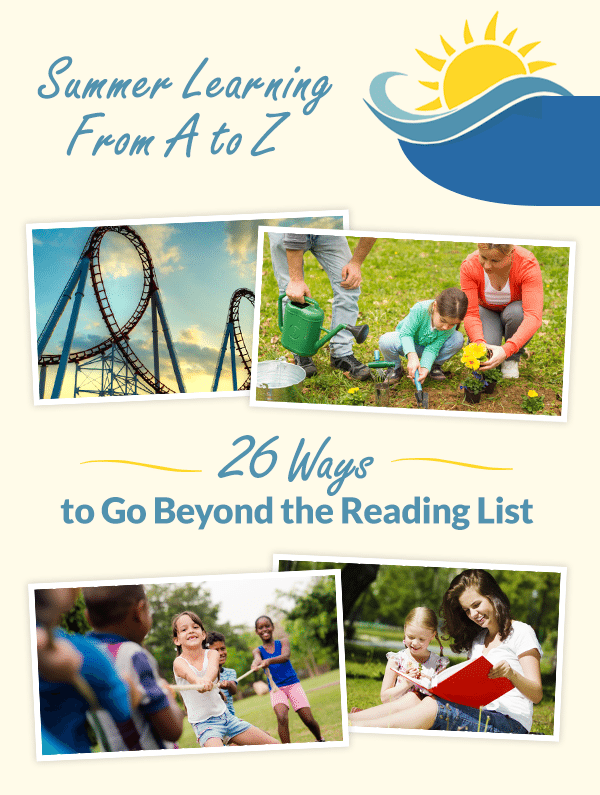We all know how important it is that kids continue reading, writing and problem-solving over the summer so they don’t come back to school at a significant disadvantage. But the long break also offers a unique opportunity for students to learn, play, and explore outside the traditional school setting.
We believe that summer learning shouldn’t look like classroom learning, and that assigning everyone the same book to read and write a one-paragraph response should be a thing of the past. That’s why we’ve rounded up 26 ways kids can keep learning over the summer that are fun, engaging and hands-on.
We’ve also created a printable of our ideas that you can easily share with parents, which you can download below. And be sure to sign up for the ThinkStretch newsletter to receive more ideas all summer long!
Summer Learning From A to Z

Download the Printable in Color
Download the Printable in B&W
Apps:
Educational apps are a great way to reinforce key skills. Have your kids write mini-reviews of the apps they play to extend the learning further.
Bowling:
Many bowling centers offer free games to kids over the summer. Or you can try bowling at home! Watch YouTube videos on the physics of bowling in advance.
Cooking:
Following a recipe helps kids practice their nonfiction skills, and measuring reinforces fractions, volume and mass.
Design:
Invite kids to redecorate a small space or even a whole room. But first, ask them to graph their plans and make a budget.
Engineering:
Try a simple engineering challenge, such as building a bridge from marshmallows and toothpicks.
Film:
Many movie theaters offer a summer discount program for kids. Look for movies that have a connection to books, then talk about the differences.
Gardening:
Gardening teaches kids about spatial planning, design and the needs of plants and animals. And a “garden” can be the size of a small pot!
Hiking:
Hiking offers lots to observe and talk about, and you don’t even have to be in the great outdoors! Look for recommended urban hikes in your area.
Instagram:
Challenge kids to start an account where they preserve shapes they find in nature, letters on cool signs or even fun bumper stickers.
Journaling:
Invite kids to keep a travel journal, a book journal or a brainstorm box—the possibilities are endless!
Kite flying:
Can kids build a kite that actually flies? What are the best conditions for kite flying? This is an activity that leads to observations galore!
Libraries:
Chances are, your local library system offers a summer program that goes way beyond books; science, music and art are often on deck!
Minecraft:
Google “learning with Minecraft” to find out how you can turn your kid’s obsession into a meaningful educational experience.
Nighttime fun:
Have kids read books about space or the history of constellations, then observe the starry night sky.
Outdoor games:
Challenge kids to create their own Olympic events (such as a ring toss or an obstacle course) using household materials.
Puzzles:
Puzzles improve concentration, fine motor skills and spatial thinking, all of which play into school success.
Quiet time:
Build in time for rest, reading, and relaxation even for older kids. Their brains will need a break after getting such a workout! Hand out this bookmark for extra inspiration.
Roller coasters:
A trip to the amusement park offers the chance to talk about physics and engineering. Google “roller coaster STEM” for help.
Sidewalk chalk:
Encourage kids to write poems along with rainbows and dragons, or challenge them to draw an interesting shape. You could also try this place value activity.
Tide pools:
If you live near the beach, have kids document what they find in photos and writing. (If you’re landlocked, try a small corner of a yard.)
Umbrella walks:
Take a stroll on a rainy day and ask kids what they see, smell, hear and feel. Then write a rainy-day sensory poem.
Vacations:
If you’re going on a trip, read books about your destination and study maps in advance. If you’re staying home, plan a dream trip instead.
Workbooks:
Today’s workbooks have come a long way in challenging kids to think creatively. We love the summer-learning ones from ThinkStretch.
Xbox writing:
If you have a die-hard gamer, challenge him or her to write an instruction manual or guide for a favorite game.
Yesterday and today:
Begin each day with a simple activity: Ask kids to write about what they did yesterday and what they want to do today.
Zoos:
Read a book about a favorite animal, then pay it a visit at your local zoo (many offer free family days during the summer).
Want more help with summer learning? Check out the fun, engaging summer learning programs available from ThinkStretch!

This article is the second in a two-part series on summer learning sponsored by ThinkStretch. Click here to read the first post in the series.
